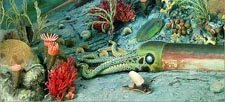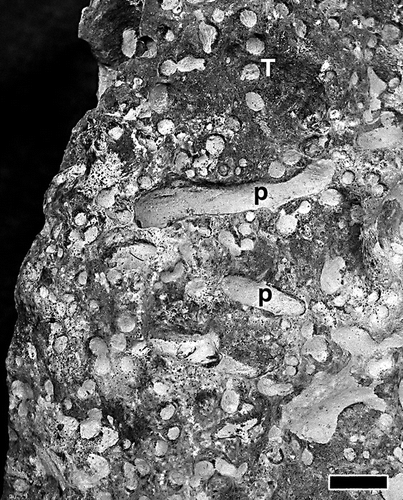 |
 |
 |
 |
 |
Produced
by the Population Genetics and Evolution class, Furman University |
||||
 |
 |
 |
 |
 |
Produced
by the Population Genetics and Evolution class, Furman University |
||||
 |
The
Ordovician: The 'bioerosion revolution' |
 |
||
| During the
Ordovician period, there was a significant increase in "boring fauna"
that caused the bioerosion of hard carbonate substrates produced by organisms
such as corals and carbonate sponges (stromatoporoids). There were over
six different macroboring "ichnogenera" (trace fossil genera),
separate from Oichnus drill borings on mollusc shells (Wilson and Palmer
2001). One of the macroborings is known as Trypanites, which
is an important bioeroder of calcium carbonate substrates (Wilson and
Palmer 2006). They were worm boring organisms that excavated over 40%
of the corals that have been examined (Tapanilla et al. 2004). Palaeosabella
were long and cylindrical, and they were very similar to Trypanites.
However, the most common borings were made by Gastrochaenolites,
which bored into thick shells and carbonate hardgrounds. A few other important
types include Petroxestes, which are the earliest know borings
by bivalves, and Cicatricula, which are possibly the earliest
borings of true sponges. While the different types of macroborings have
been discovered, it is still hard to measure the intensity of boring.
This is the number of borings per unit of hard substrate area; however,
it is difficult to measure due to the amount of time it has been exposed
to the elements of the seafloor Wilson and Palmer 2006). The
importance of this 'bioerosion revolution' is that is demonstrates that
many organisms were adapting to the hard parts evolved by other species;
either as preators adapting drilling strategies, or as anchoring strategies
to hold fast to the hard substrate. Page by Lindsay Gerzel |
 |
| Penetration of Clathrodictyon by Trypanites (T). Tapanila et al. 2004. | |
|
Tapanila L, Copper P, Edinger E. 2004. Environmental and substrate control on Paleozoic Bioerosion in corals and stromatoporoids, Anticosti Island, Eastern Canada. Palaios 19:292-306. Wilson MA, Palmer TJ. 2006. Patterns and processes in the Ordovician bioerosion revolution. 2006. Ichnos 13:109-112. Wilson MA, Palmer TJ. 2001. The Ordovician bioerosion revolution. GSA Annual Meeting. November 7, 2001. |